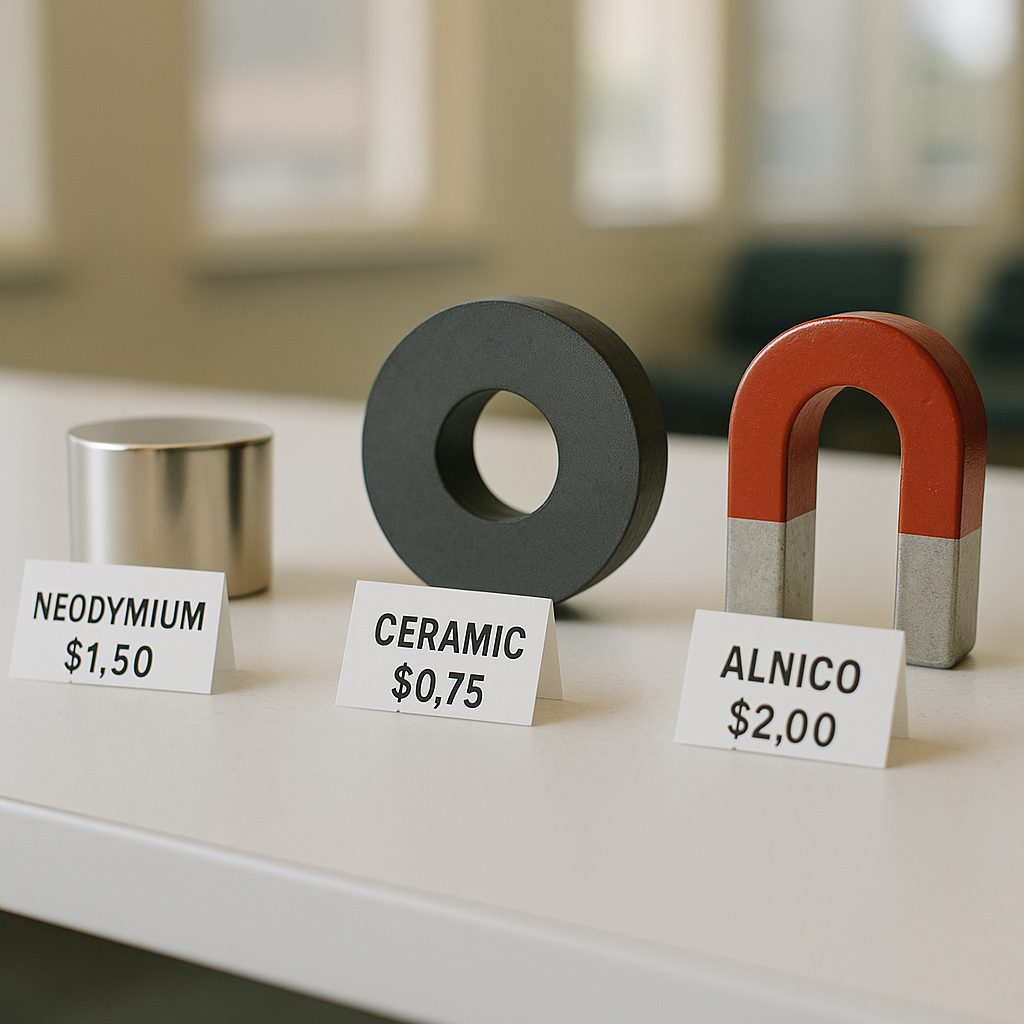5901 Botham Jean Blvd, Dallas, TX 75215
What is the Current Pricing Range for Neodymium Magnets?
June 30, 2025Neodymium magnets are among the most powerful permanent magnets available today. Their prices vary considerably based on several factors. Small neodymium magnets, measuring approximately 3mm x 3mm, can be purchased for as little as $0.10 each, making them accessible for hobbyists and small projects.
Medium-sized neodymium magnets, typically around 10mm x 5mm, are more expensive, generally costing between $1 and $5 each. This price increase reflects their greater magnetic strength and material volume. These mid-range options are commonly used in various commercial and industrial applications.
For larger or specialized neodymium magnets, the price can rise significantly. Larger disc magnets, specialty shapes, or high-grade options may cost $10 or more per unit. The current rare earth metal market significantly influences these prices, as neodymium is classified as a rare earth element with fluctuating global availability and demand.
How Do Neodymium Magnet Prices Compare to Other Types?

When comparing neodymium magnets to other types, such as samarium cobalt magnets, the price difference can be substantial. A typical neodymium disc magnet costs between $0.10 and $10, while a block samarium cobalt magnet can range from $1 to $100 or more. This significant price gap results from several key factors affecting both production and performance.
The raw materials used in manufacturing play a major role in this price disparity. Neodymium magnets are made from neodymium, iron, and boron—materials that are relatively abundant and contribute to their cost-effectiveness. In contrast, samarium cobalt magnets require rarer elements like samarium and cobalt, which are less abundant and more costly to source.
Manufacturing complexity also influences pricing. Samarium cobalt magnets require more sophisticated production techniques, increasing their overall cost. The sintering process for these magnets involves higher temperatures and more precise control than what is needed for neodymium alternatives.
Market dynamics further widen this price gap. Neodymium magnets have become increasingly popular across various industries, leading to larger production volumes and economies of scale. This widespread adoption has helped drive down costs. Samarium cobalt magnets, used primarily in specialized applications, have a smaller market demand and production volume.
Despite being more expensive, samarium cobalt magnets offer superior performance in certain conditions that justify their higher price. They maintain magnetic strength at higher temperatures (up to 350°C compared to neodymium’s 80-200°C) and provide better corrosion resistance without needing protective coatings.
For high-temperature industrial applications, some manufacturers use specialized neodymium magnets with added dysprosium to improve heat resistance. While these enhanced neodymium magnets cost more than standard versions, they generally remain less expensive than comparable samarium cobalt options.
What Factors Influence Neodymium Magnet Pricing?

Raw material costs significantly influence neodymium magnet pricing, accounting for about 80% of the total cost. These magnets are primarily made of neodymium, praseodymium, dysprosium, and other rare earth elements, which make up approximately 29-32.5% of the magnet’s weight. Current global neodymium prices are about US$68.05/KG, forming the foundation for additional pricing factors.
Magnet grade greatly impacts cost. NdFeB magnets are categorized in series like N30 through N52, with higher numbers indicating stronger magnetic properties. Higher-grade magnets are more expensive because they require more precise manufacturing processes and generally contain larger amounts of costly rare earth elements. For example, an N52 grade magnet can cost 20-30% more than an N35 grade of the same size.
Size and shape complexity create notable price differences. Standard shapes such as blocks, discs, and cylinders are more economical to produce. However, specialized configurations, like arc segments for motors or thin rings, require advanced manufacturing techniques. These complex shapes often involve more machining, material waste, and specialized equipment, which can increase prices by as much as 40-50% compared to simple shapes.
Manufacturing processes add another pricing layer. Sintered NdFeB magnets—the strongest commercial type—require specialized equipment and precise temperature control during production. Coating treatments, such as nickel, zinc, or epoxy, enhance corrosion resistance but add to costs. Precision tolerances further affect price, with tighter tolerances necessitating meticulous processing and quality control.
Order quantity plays a significant role in pricing through economies of scale. Bulk purchases usually receive substantial discounts as setup costs are spread across more units. Small orders of specialized magnets may be significantly more expensive per unit than large production runs. Manufacturers often establish minimum order quantities to maintain production efficiency.
Market conditions can introduce volatility to neodymium magnet pricing. China accounts for over 80% of the world’s rare earth element production, making global prices vulnerable to policy changes or export restrictions. Fluctuations in industry demand, particularly from sectors like electric vehicles and wind turbines, can rapidly affect availability and pricing throughout the supply chain.
Where Are Neodymium Magnets Commonly Used?

Neodymium magnets are the powerhouses of the permanent magnet world. These exceptional materials have become indispensable in countless applications due to their remarkable strength-to-size ratio. The magnetic energy product of neodymium magnets can reach up to 52 MGOe, significantly outperforming other magnetic materials.
Consumer Electronics Applications
In compact electronic devices, neodymium magnets play a crucial role. Smartphones rely heavily on these magnets for multiple components. The speakers in your phone use neodymium magnets to produce clear sound while maintaining the slim profiles we expect.
Beyond smartphones, these magnets appear in various acoustic components across the electronics spectrum. Tablets and laptops incorporate neodymium magnets in their speakers, though they often use slightly lower-grade options like N52SH compared to the N54SH found in phones. This strategic choice balances sound quality with cost-effectiveness.
Smartwatches, with their minimal space and basic sound requirements, typically use N50H grade magnets. These provide adequate performance while conserving space in the compact device housing.
Motor Components in Electronics
The functionality of many electronic devices depends on tiny motors powered by neodymium magnets. Voice Coil Motors (VCMs) in smartphone cameras rely on arc-shaped neodymium magnets that are usually less than 1mm thick. These magnets enable the precise lens movements needed for autofocus capabilities.
Another critical application is in Linear Resonance Actuators (LRAs), which provide the vibration feedback in our devices. These motors generate precise vibrations through the interaction between a coil-generated magnetic field and a fixed neodymium magnet. The strength and pattern of these vibrations can be finely controlled by adjusting the electrical current.
Magnetic Attachment Technology
Modern devices rely heavily on neodymium magnets for magnetic attachment capabilities. Apple’s MagSafe technology is a prime example, using N52 or N52SH grade magnets arranged in a ring formation. This configuration ensures proper alignment for wireless charging while maintaining a secure connection.
Similar magnetic attachment systems appear in laptop screen closures, tablet supports, and accessories. These applications leverage the attraction between neodymium magnets and ferromagnetic materials to create convenient, secure connections.
Industrial and Scientific Applications
Beyond consumer electronics, neodymium magnets have transformed numerous industrial sectors. In aerospace and defense industries, these magnets feature prominently in control systems and motors. Their excellent strength-to-weight ratio helps reduce overall weight while maintaining or improving system efficiency.
The renewable energy sector also benefits significantly from neodymium magnets. Wind turbines use these magnets in their generators to convert mechanical energy into electricity efficiently. Similarly, various motor designs in electric vehicles and industrial machinery incorporate neodymium magnets to maximize performance while minimizing size and weight.
In scientific research and medical equipment, neodymium magnets enable advancements in imaging technology, positioning systems, and specialized research apparatus. Their reliability and consistent performance make them invaluable in these precision-critical applications.
Conclusion: Understanding Neodymium Magnet Prices

Understanding neodymium magnet prices involves several key factors. Raw material costs, manufacturing processes, and magnet grade, shape, and size significantly influence the final price. These powerful magnets can cost anywhere from a few cents for small consumer-grade products to hundreds of dollars for specialized industrial applications.
Currently, neodymium prices fluctuate due to geopolitical factors, supply chain dynamics, and increased demand from sectors like renewable energy and electric vehicles. For organizations requiring these essential components, partnering with experienced recycling companies is crucial. Contact Okon Recycling at 214-717-4083 for sustainable solutions to manage costs while supporting your specific magnet needs.
